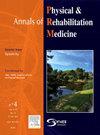Early intervention vocational rehabilitation for return to work following traumatic injury: A randomized controlled trial
IF 4.6
3区 医学
Q1 REHABILITATION
Annals of Physical and Rehabilitation Medicine
Pub Date : 2025-04-29
DOI:10.1016/j.rehab.2025.101972
引用次数: 0
Abstract
Background
Returning to work (RTW) is an important goal for individuals sustaining traumatic injury (Multi-Trauma Orthopaedic [MTO], traumatic brain injury [TBI], and spinal cord injury [SCI]). Vocational rehabilitation is often unavailable or delayed, and controlled evaluation limited.
Objectives
This study evaluated the impact of providing an Early Intervention Vocational Rehabilitation Service (EIVRS) following traumatic injury on employment outcomes, mental health and quality of life 1- and 2-years post-injury.
Methods
A randomised parallel 2-group design was used to compare the EIVRS group with a control group receiving usual rehabilitation. Outcomes included hours worked and time to return to first job (primary outcomes), anxiety, depression and quality of life 1- and 2-years post-injury. Participants were adults aged 16–70, employed pre-injury. Eighty-eight EIVRS treatment and 82 controls were recruited; mean 47 days post-injury, 75% male, mean age 38 years. Dedicated EIVRS therapists provided activities associated with fostering hope for RTW, thinking about and preparing for returning to work, building RTW goals into rehabilitation, identifying an employer liaison, and peer support.
Results
There were no significant group differences in employment outcomes at 1-year follow-up, but EIVRS participants reported lower anxiety. Median quartile regressions revealed that at 2-year follow-up, the EIVRS group worked more hours (38, 24; 40) and took significantly less time from injury to RTW (166, 87; 280) than controls (29, 23; 36 and 238, 144; 325). Quartile regressions by diagnosis showed a significant main effect of group (P = 0.02) but no interaction between group and diagnosis (P = 0.60). Trends for shorter time to RTW were strongest in the MTO and TBI groups at 2 years. At 2 years there were no group differences in anxiety, depression or quality of life.
Conclusions
Offering EIVRS may reduce time to RTW and increase hours worked 2 years after traumatic injury.
Trial registration
#ACTRN12619000521123.
创伤后重返工作岗位的早期干预职业康复:一项随机对照试验
重返工作岗位(RTW)是遭受创伤性损伤(多创伤骨科[MTO]、创伤性脑损伤[TBI]和脊髓损伤[SCI])的个体的重要目标。职业康复往往无法获得或延迟,控制评估有限。目的评估创伤后早期干预职业康复服务(EIVRS)对创伤后1年和2年就业结局、心理健康和生活质量的影响。方法采用随机平行2组设计,将EIVRS组与常规康复对照组进行比较。结果包括工作时间和重返第一份工作的时间(主要结果)、焦虑、抑郁和受伤后1年和2年的生活质量。参与者是16-70岁的成年人,在受伤前受雇。EIVRS组88例,对照组82例;平均伤后47天,75%男性,平均年龄38岁。专门的EIVRS治疗师提供了与培养RTW希望,思考和准备重返工作,将RTW目标纳入康复,确定雇主联络人以及同伴支持相关的活动。结果在1年的随访中,EIVRS参与者在就业结果上没有显著的组间差异,但他们的焦虑水平较低。中位数四分位数回归显示,在2年随访中,EIVRS组工作时间更长(38,24;40),并且从受伤到RTW所需的时间显著缩短(166,87;280)比对照组(29,23;36和238,144;325)。诊断四分位数回归显示组间主效应显著(P = 0.02),组与诊断间无交互作用(P = 0.60)。在MTO组和TBI组中,2年至RTW时间较短的趋势最强。两年后,各组在焦虑、抑郁或生活质量方面没有差异。结论采用EIVRS可减少创伤后2年复工时间,增加工作时数。试验注册# ACTRN12619000521123。
本文章由计算机程序翻译,如有差异,请以英文原文为准。
求助全文
约1分钟内获得全文
求助全文
来源期刊

Annals of Physical and Rehabilitation Medicine
Medicine-Rehabilitation
CiteScore
7.80
自引率
4.30%
发文量
136
审稿时长
34 days
期刊介绍:
Annals of Physical and Rehabilitation Medicine covers all areas of Rehabilitation and Physical Medicine; such as: methods of evaluation of motor, sensory, cognitive and visceral impairments; acute and chronic musculoskeletal disorders and pain; disabilities in adult and children ; processes of rehabilitation in orthopaedic, rhumatological, neurological, cardiovascular, pulmonary and urological diseases.
 求助内容:
求助内容: 应助结果提醒方式:
应助结果提醒方式:


